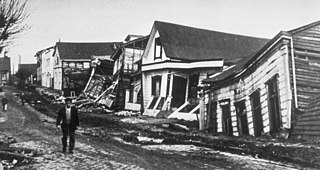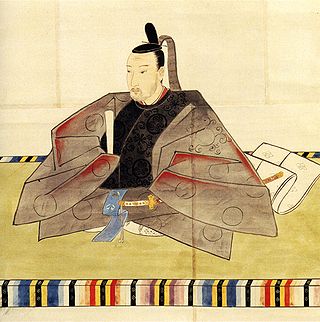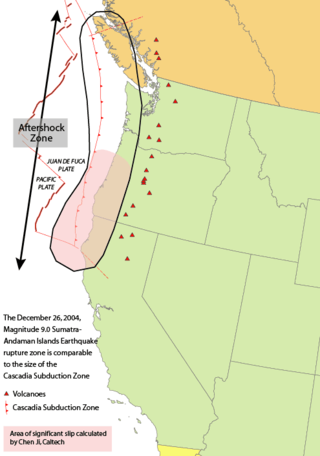| |||||
| Decades: | |||||
|---|---|---|---|---|---|
| See also: | |||||
Events in the year 1858 in Japan .
| |||||
| Decades: | |||||
|---|---|---|---|---|---|
| See also: | |||||
Events in the year 1858 in Japan .
| | This section is empty. You can help by adding to it. (December 2021) |
| | This section is empty. You can help by adding to it. (December 2021) |

An earthquake is the shaking of the surface of the Earth resulting from a sudden release of energy in the Earth's lithosphere that creates seismic waves. Earthquakes can range in intensity, from those that are so weak that they cannot be felt, to those violent enough to propel objects and people into the air, damage critical infrastructure, and wreak destruction across entire cities. The seismic activity of an area is the frequency, type, and size of earthquakes experienced over a particular time. The seismicity at a particular location in the Earth is the average rate of seismic energy release per unit volume. The word tremor is also used for non-earthquake seismic rumbling.
November 17 is the 321st day of the year in the Gregorian calendar; 44 days remain until the end of the year.

A tsunami is a series of waves in a water body caused by the displacement of a large volume of water, generally in an ocean or a large lake. Earthquakes, volcanic eruptions and other underwater explosions above or below water all have the potential to generate a tsunami. Unlike normal ocean waves, which are generated by wind, or tides, which are in turn generated by the gravitational pull of the Moon and the Sun, a tsunami is generated by the displacement of water from a large event.
1931 (MCMXXXI) was a common year starting on Thursday of the Gregorian calendar, the 1931st year of the Common Era (CE) and Anno Domini (AD) designations, the 931st year of the 2nd millennium, the 31st year of the 20th century, and the 2nd year of the 1930s decade.
1924 (MCMXXIV) was a leap year starting on Tuesday of the Gregorian calendar, the 1924th year of the Common Era (CE) and Anno Domini (AD) designations, the 924th year of the 2nd millennium, the 24th year of the 20th century, and the 5th year of the 1920s decade.
1927 (MCMXXVII) was a common year starting on Saturday of the Gregorian calendar, the 1927th year of the Common Era (CE) and Anno Domini (AD) designations, the 927th year of the 2nd millennium, the 27th year of the 20th century, and the 8th year of the 1920s decade.

Atami is a city located in Shizuoka Prefecture, Japan. As of 1 May 2019, the city had an estimated population of 36,865 in 21,593 households and a population density of 600 persons per km2. The total area of the city is 61.78 square kilometres (23.85 sq mi).

The 1960 Valdivia earthquake and tsunami or the Great Chilean earthquake on 22 May 1960 was the most powerful earthquake ever recorded. Various studies have placed it at 9.4–9.6 on the moment magnitude scale. It occurred in the afternoon, and lasted for approximately 10 minutes. The resulting tsunamis affected southern Chile, Hawaii, Japan, the Philippines, eastern New Zealand, southeast Australia, and the Aleutian Islands.
The Clyde Dam, New Zealand's third-largest hydroelectric dam, is built on the Clutha River / Mata-Au near the town of Clyde. It is owned and operated by Contact Energy.

Tokugawa Iesada was the 13th shōgun of the Tokugawa shogunate of Japan. He held office for five years from 1853 to 1858. He was physically weak and was therefore considered by later historians to have been unfit to be shōgun. His reign marks the beginning of the Bakumatsu period.

The 1700 Cascadia earthquake occurred along the Cascadia subduction zone on January 26, 1700, with an estimated moment magnitude of 8.7–9.2. The megathrust earthquake involved the Juan de Fuca Plate from mid-Vancouver Island, south along the Pacific Northwest coast as far as northern California. The length of the fault rupture was about 1,000 kilometers, with an average slip of 20 meters (66 ft).

Ansei (安政) was a Japanese era name after Kaei and before Man'en. This period spanned the years from November 1854 through March 1860. The reigning emperor was Kōmei-tennō (孝明天皇).
The Hietsu earthquake was a doublet earthquake that took place on April 9, 1858. It most likely occurred on the Atotsugawa and Miboro faults, which connect the Amō Pass in Gifu Prefecture and Mount Tate in Toyama Prefecture on the island of Honshū in Japan. Its name includes one kanji from Hida (飛騨国) and one from Etchū (越中国). The earthquakes are estimated to have killed 200–300 people. It also caused the Mount Tonbiyama landslide and blocked the upper reaches of the Jōganji River.

Toyama Castle is a flatland-style Japanese castle located in the city of Toyama, Toyama Prefecture, in the Hokuriku region of Japan. It is also called Azumi Castle. Built in 1543, the castle and its surrounding land is maintained by the government of Japan as a public park.

The 1978 Miyagi earthquake occurred at 17:14 local time on 12 June. The epicentre was offshore of Miyagi Prefecture, Japan. It had a surface wave magnitude of 7.7, JMA magnitude 7.4, and triggered a small tsunami. The earthquake reached a maximum intensity of Shindo 5 in Sendai and caused 28 deaths and 1,325 injuries.

The 1855 Edo earthquake, was the third Ansei Great Earthquake, which occurred during the late-Edo period. It occurred after the 1854 Nankai earthquake, which took place about a year prior. The earthquake occurred at 22:00 local time on 11 November. It had an epicenter close to Edo, causing considerable damage in the Kantō region from the shaking and subsequent fires, with a death toll of 7,000–10,000 people and destroyed around 14,000 buildings. The earthquake had a magnitude of 7.0 on the surface wave magnitude scale and reached a maximum intensity of XI (Extreme) on the Mercalli intensity scale. The earthquake triggered a minor tsunami.